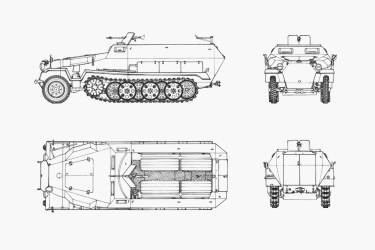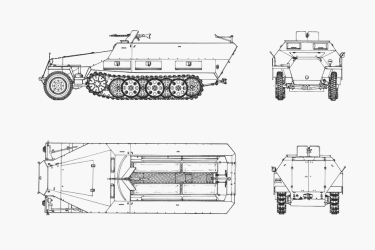




The SdKfz 251 was the most well-known and widely produced armored personnel carrier of the German Army during World War II, to the extent that it was simply referred to as the 'Hanomag' by both German and Allied soldiers. It was designed by Hanomag on the basis of the SdKfz 11 which was fitted with an armored hull. This was relatively thick by APC standards and the added sloping which offered protection against small-caliber fire although the open top was a vulnerabilty to plunging fire and lobbed weapons. However, it did allow troops to fight from inside the vehicle. Firepower came in the form of a single MG 34 or 42 machine gun although specialized versions could carry a huge variety of weapons including anti-aircraft cannons, flamethrowers, and up to 75-mm anti-tank guns. Nearly two dozen variants of the SdKfz 251 were built and it fulfilled roles such as command vehicles, ammunition carriers, artillery tractors, artillery observation, and armored ambulance, making it one of the most versatile vehicles of World War II. The SdKfz 251 was available in small numbers when the war began, and were issued to Panzer and Panzergrenadier divisions beginning with the 1st Panzer Divison in 1939. In contrast to the smaller SdKfz 250 which was issued preconnaissance units, the SdKfz 251 equipped motorized infantry units enabling them to keep up with the Panzers. The SdKfz 251 served throughout the entirety of the war with small numbers provided to other smaller Axis forces.
The Mittlerer Schützenpanzerwagen (SdKfz 251) began production in June 1939 with production eventually undertaken by no less than seven different manufacturers besides Hanomag. The basic APC version came in four different variants starting from the Ausf A with distinctive early vision slits, while the Ausf B had a single vision port for driver and commander, and the Ausf C featured added protection including an armored shield for the machine gun. The Ausf D was noticeably different with a simplified superstructure and reduced number of armor plates. A large number of non-APC variants were built or proposed. Fire-support variants included the SdKfz 251/9 with a 7.5cm KwK 37 gun, SdKfz 251/10 with a 3.7cm PaK 26 anti-tank gun, and SdKfz 251/2 with a 7.5cm PaK 40. The SdKfz 251/16 was a flamethrower vehicle. Anti-aircraft versions included the SdKfz 251/17 with a 2cm KwK 38 and the SdKfz 251/21 with a MG 151 autocannon. Non-combat variants included the SdKfz 251/2 mortar carrier, SdKfz 251/3 communications vehicle, SdKfz 251/4 artillery tractor, SdKfz 251/5 and 251/6 armored engineer vehicle, SdKfz 251/6 command vehicle, SdKfz 251/9 armored ambulance, SdKfz 251/11 telephone layer and 251/19 telephone exchange vehicle, and SdKfz 251/20 infrared searchlight.
Preceded by:
NoneSucceeded by:
None |  | |
| Design | mSPW Ausf C | mSPW Ausf D |
| Type | APC | APC |
| Year | 1939 | 1943 |
| Crew | 2 | 2 |
| Dimensions | ||
| Length (w/Gun) | 5.80 m | 5.98 m |
| Width | 2.100 m | 2.100 m |
| Height | 1.750 m | 1.750 m |
| Ground Clearance | 0.300 m | 0.300 m |
| Track | 0 m | 0 m |
| Track Width | 28 mm | 28 mm |
| Track on Ground | 1.800 m | 1.800 m |
| Weight | ||
| Combat | 7,810 kg | 8,000 kg |
| Ground Pressure | 1.24 kg/cm² | 0 kg/cm² |
| Suspension | Torsion bar | Torsion bar |
| Performance | ||
| Speed (Off-Road) | 53 km/h (21 km/h) | 53 km/h (21 km/h) |
| Range (Off-Road) | 300 km (150 km) | 300 km (150 km) |
| Amphibious | No | No |
| Fording | 0.50 m | 0.50 m |
| Trench | 1.98 m | 1.98 m |
| Gradient | 24% | 24% |
| Powerplant | ||
| Engine | 1 x 100-hp Maybach HL 42 TUKRM | 1 x 100-hp Maybach HL 42 TUKRM |
| Fuel | Gasoline: 160 L | Gasoline: 160 L |
| Power/Weight | 12.80 hp/t | 12.50 hp/t |
| Armament | ||
| Main | None | None |
| Secondary | pintle:2 x 7.92-mmMG 34 | pintle:2 x 7.92-mmMG 34 |
| Ammo | 7.92-mm: 2,010 | 7.92-mm: 2,010 |
| Armor | ||
| Type | Steel | Steel |
| Thickness | 6 - 15 mm | 6 - 15 mm |
| Max Effective | 16 mm RHAe | 16 mm RHAe |
| Hull Upper Front | 10 mm / 33° | 10 mm / 33° |
| Hull Lower Front | 14.5 mm / 21° | 15 mm / 22° |
| Hull Upper Sides | 8 mm / 35° | 8 mm / 35° |
| Hull Lower Sides | 8 mm / 35° | 8 mm / 35° |
| Hull Upper Rear | 8 mm / 40° | 8 mm / 33° |
| Hull Lower Rear | 8 mm / 30° | 8 mm / 33° |
| Hull Bottom | 6 mm / 6° | 6 mm / 6° |
| Production | ||
| Built | 4,650 | 10,602 |
| Total | 4,165 |